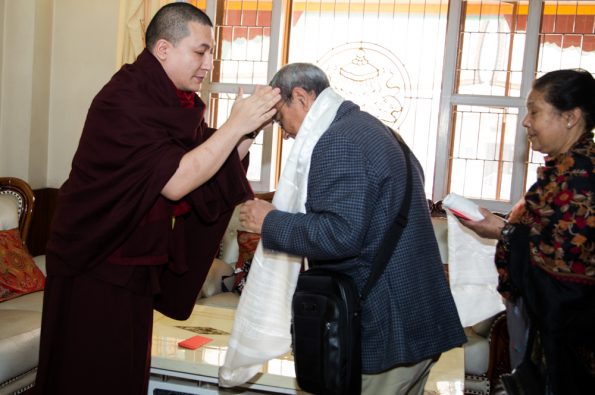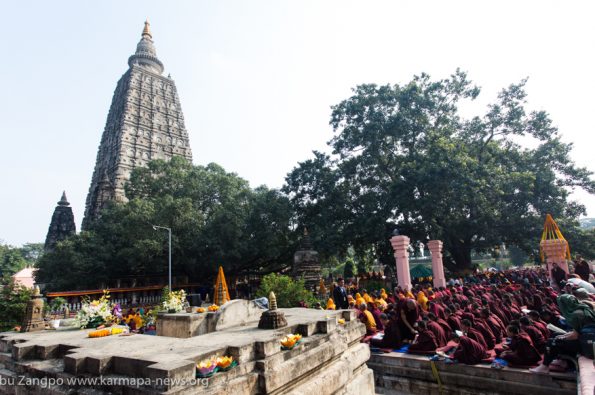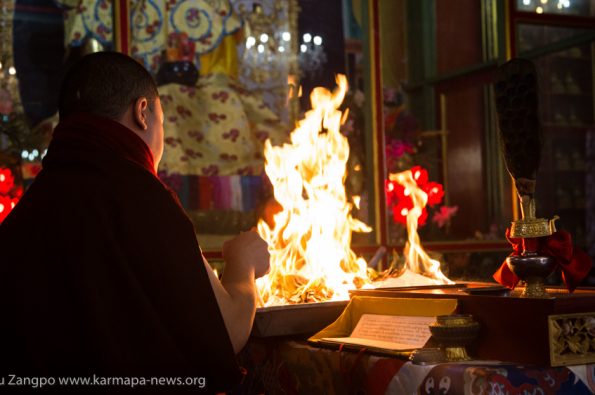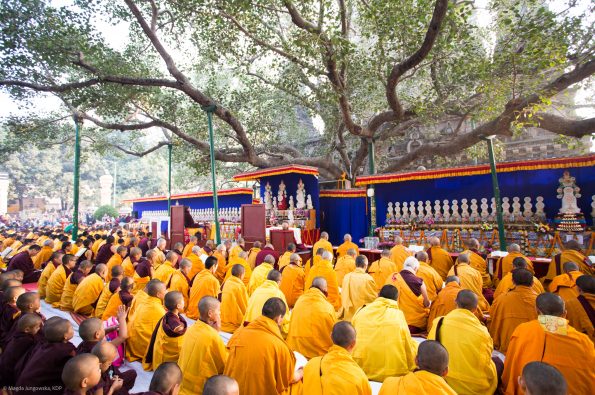Karmapa gives teaching on the anniversary of the parinirvana of Shamar Rinpoche
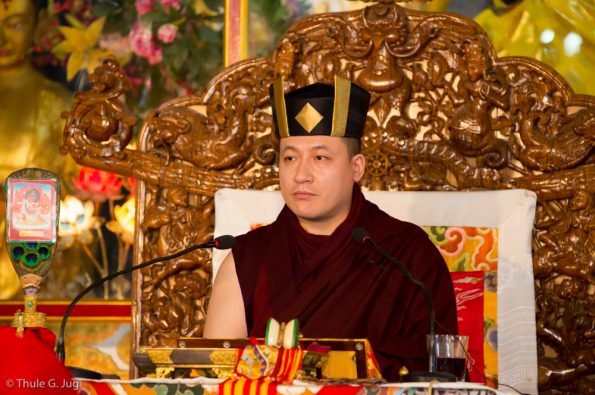
On the day of the full moon, Thaye Dorje, His Holiness the 17th Gyalwa Karmapa, shares the following reflections on the day of the anniversary of the parinirvana of Mipham Chökyi Lodrö, His Holiness the 14th Kunzig Shamar Rinpoche, and Buddha Shakyamuni, according to the Tibetan calendar.
Today is or was… and as I say this I cannot help but almost say: today will be… the anniversary of the day when our great spiritual friend showed the pattern of dissolving his physical manifestation as His Holiness the 14th Kunzig Shamar Rinpoche – the Buddha of our time.
To most of us, this remembrance might be thought of as a moment to mourn the loss of this display of his form.
As if it was a finale.I never feel that this was his intent.
Because that would bring in us a feeling of isolation, a sense of being outcast and abandoned like an orphan.
So, let us take this anniversary of his Parinirvana as an opportunity to understand his natural intent.
On the soil of Alaya, the ground of being, whatever rises will inevitably fall.
Be it a proper or virtuous rising, or an improper or non-virtuous rising – it will eventually fall.
Buddhas appearing as Bodhisattvas realise this pattern.
They have overcome the fallacy of ignoring this pattern of nature.
Karma.
And they have wholeheartedly accepted that all things that go up will fall in the end.
Accepting this fact won’t bring sorrow.
Even if this experience of acceptance may be overwhelming, it isn’t sorrow.
The real sorrow is the non-acceptance of this fact.
This non-acceptance gets us stuck in our head, in our thoughts, in our concepts.
The Parinirvana is a symbol of this acceptance, displayed in appearance.
Haven’t we felt, time and again, the overwhelming feeling of loss when something we felt we knew well disappeared?
And, in particular, when the disappearance of a being dear to us – not necessarily a teacher but a true friend, a དགེ་བའི་བཤེས་གཉེན། (dge ba’i bshes gnyen, ge wey she nyen) – sparked the inevitability of change in us in various ways, haven’t we felt the jolt, the loss?
Well, if we feel like mourning, then mourning for having mistaken this experience of loss as sorrow and unhealthy, could be a reason to mourn.
The Bodhisattvas aren’t going anywhere.
We aren’t going anywhere or being left behind anywhere.
There aren’t any real losses.
But misunderstanding the vanishing display of the Bodhisattvas as going somewhere is the hang up.
That’s the sorrow.
Equally, misunderstanding ourselves as being left alone and outcast is a hang up too.
That’s a sorrow as well.
Indulging in and entertaining the idea of such hang ups is the real sorrow.
It is sorrow because the truth is far from how it appears.
If we nevertheless feel stuck, then we can try either temporarily going further ahead towards the appearance, or stepping further back from it.
Going towards the appearance means facing or confronting the facts. For example, if you have a fear of heights, then immerse yourself in the experience and overcome that fear.
An example of stepping further back is when you are too close to a painting and you can’t make sense of what you see. Stepping back allows you to really see the painting.
In other words, there are layers of patterns, and in order to appreciate a particular pattern, sometimes you need to get closer and sometimes you need to step back.
If you do that then something might happen.
Then, in time, even the feeling of sorrow can be talked about and even laughed about because we realise that it was a hang up.
The awakened ones’ intent is really an aspiration for us to arrive at that humorous point.
Their aspiration is intended for us to come out of our conceptual knots, to be able to laugh about tangling ourselves over unimaginably long durations.
Dear dharma friends, kindly take a moment to acquaint yourselves with this unbinding practice called Guru Yoga, and particularly with this Guru Yoga:
The Celebration of the Accomplishment of Blessing,
the Guru Yoga of the 14th Shamarpa,
Mipham Chökyi Lodrö, the Supreme Protector.
This practice and for that matter all Buddhist practices are not commandments.
They are not decrees.
They are not teachings.
They are momentary and spontaneous skilful means – surprises even, like a loving mother with her baby in the water, temporarily letting go to give the baby a chance to learn to swim – intended or aspired from compassion.
Kindly delight yourselves in this practice.
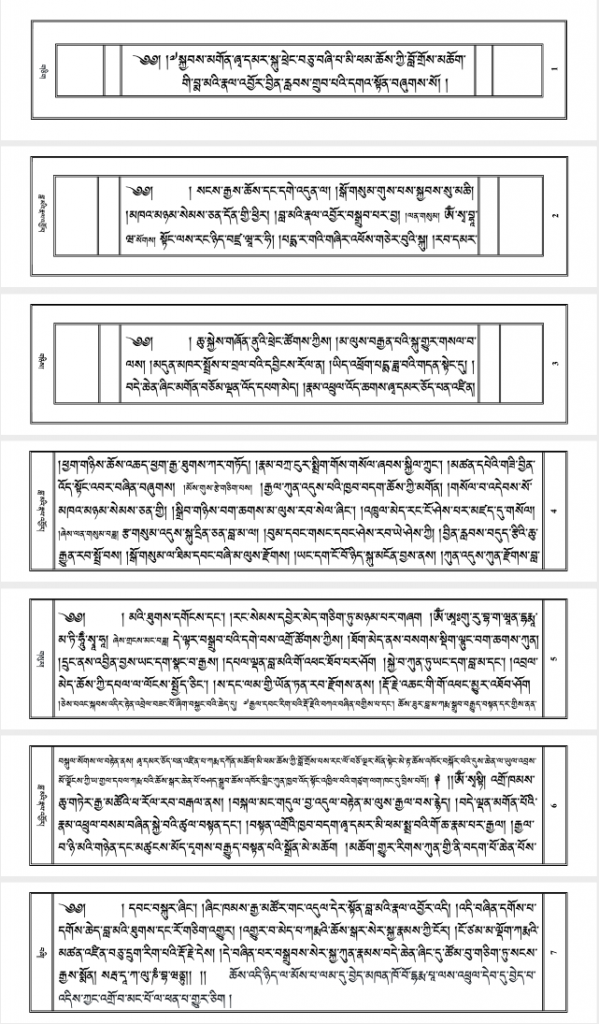
English translation
The Celebration of the Accomplishment of Blessing,
the Guru Yoga of the 14th Shamarpa,
Mipham Chökyi Lodrö, the Supreme Protector
sang gyé chö dang gen dün la |
With reverence, through body, speech, and mind,
go sum gü pé kyab su* chi | [*u = is pronounced “oo” like in “boot”]
I go for refuge to the Buddha, the Dharma and the Sangha.
kha nyam sem chen dön gyi chir |
For the sake of sentient beings equal to the sky,
la mé nal jor drub par ja | (3x)
I will practice Guru Yoga.
om sobhawa shuddha sarva dharma sobhawa shuddho hang |
tong lé rang nyi vajra varahi |
Out of emptiness I visualize my own being, Vajra Vārāhī,
pema ragé shir pö cher bü ku ||
with a naked body, appearing on a base of ruby:
rab mar chu kyé shön nü treng tshog kyi |
bright red, my body fully adorned with
ma lü gyen pé ku gyur sal wa lé |
fresh lotus garlands.
dün kar trö pa dral wé ying röl na |
In front in the sky, in the playful expanse free of conceptualizations,
yi trog pema dawé den teng du |
on a ravishing throne of lotus and moon
dé chen shing gön jom den öpamé |
is Buddha Amitābha, the Lord of Sukhavatī, in the
nam trül ö chag shamar chö pen dsin |
radiant manifestation of the Holder of the Red Crown.
chag nyi chö ché chag gya tug kar tö |
His two hands at his heart in the posture of Turning the Wheel of Dharma,
nam tra ngur mig gö söl shab kyil trung |
wearing the saffron-colored robes and having his legs in the vajra posture,
tsen pé si jin ö tong bar shin shug |
he appears in the full splendour of his major and minor marks and is blazing in boundless light.
(Repeat with focused devotion:)
gyal kün düpé khyab dag chö kyi gön |
Master, you who embody all the Victorious Ones, Dharma Protector, I supplicate you!
söl wa deb so kha nyam sem chen gyi |
Please purify all sentient beings, whose number equals the sky,
drib nyi bag chag ma lü rab sel shing |
from the two obscurations and all habitual tendencies
trül mé rang ngo shé par dse du söl | (3x)
and support us to understand our undeluded nature.
tsa sum dü ku drin chen lama la |
From the kind Lama who embodies the three roots,
bum wang sang wang sherab yeshe kyi |
flows a stream of nectar blessing: the vase-, the
jin lab dütsi chu gyün rab trö wé |
secret- and the wisdom-knowledge-empowerments.
go sum la tim wang shi ma lü dsog |
Then, dissolving into the three doors, all four empowerments are completed.
yang dag ngo wo nyi ku ngön je né |
The sublime Svabhāvikakāya is actualized:
kün dü kün dsog lamé thug gong dang |
The Lama’s wisdom mind that unites everything and is perfect in every regard
rang sem yer mé chig tu nyam par shag |
and my own mind are inseparably one. I abide in that.
om ah guru bhagawan dharma mati hung soha |
(Recite this many times)
dé tar drub pé gé wé dro tsog kyi |
By means of the virtue accomplished in this way
tog mé né sag dig tung bag chag kün |
may all the non-virtues, downfalls and habitual tendencies accumulated by all sentient beings since beginningless time
drung né jin jé yang dag nang wa gyé |
be completely uprooted, may the pure view flourish,
pal den lamé go pang tob par sho |
may we attain the state of the glorious Lama.
kyé wa kün tu yang dag lama dang |
Through all my births, may I not be separated from the
dral mé chö kyi pal la long chö ching |
perfect Lama, enjoy the splendour of the Dharma,
sa dang lam gyi yön ten rab dsog né |
and, having perfected the qualities of the paths and bhūmis,
dor jé chang gi go pang nyur tob sho |
may I swiftly attain the state of Vajradhara!

